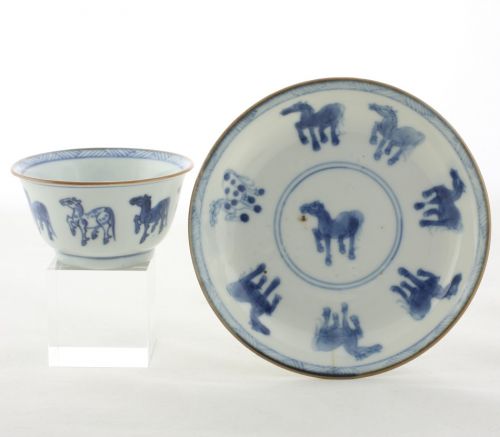
Sold Ceramics - Sold Blue and White wares since 1722 - Tea, Coffee and Chocolate wares - Page 1
Object 2011601
Teacup and saucer
China
1725-1740
Height of teacup 40 mm (1.57 inch), diameter of rim 72 mm (2.83 inch), diameter of footring 35 mm (1.38 inch), weight 50 grams (1.76 ounce (oz.))
Height of saucer 22 mm (0.86 inch), diameter of rim 116 mm (4.57 inch), diameter of footring 57 mm (2.24 inch), weight 82 grams (2.89 ounce (oz.))
Teacup and saucer on footrings, slightly everted underglaze brown-edged rims (jia mangkou). Decorated in underglaze blue with a horse in a central roundel surrounded by seven other horses. On the rims a zig-zag lines pattern border. To the reverse of the saucer three flower sprays. The teacup is decorated en suite.
The horse, Equus caballus, is one of the Seven Treasures of Buddhism, and is one of the twelve animals of the Chinese zodiac. It plays an important part in Chinese history and culture, symbolising speed, power, energy and military status. Excellent specimens of horses came to China from Central Asia, where they were indigenous. They were highly appreciated in China and incorporated into Chinese culture. Many legends are connected with famous horses. One is the story of the eight horses of the Emperor Mù Wáng, a favourite subject of Chinese artists. Mù Wáng (r. 976-922 BC) was the fifth emperor of the Western Zhou dynasty (c.1046-256 BC) and is said to have wanted to visit the gardens of the western paradise of Xiwang mu, the Queen Mother of the West, and her famous peach orchards. He set out and travelled through the empire on a chariot driven by his charioteer Tsao Fu. The chariot was being pulled by eight horses each of which bore a distinguishing name and had different 'magic' powers, such as running without touching the ground, riding a cloud or having wings. (Ströber 2011, p.91), (Williams 1976, p.223)
In the Netherlands this particular design of the eight horses of Emperor Mù Wáng was reffered to as the paardenstoeterij, stud farm. (Hartog 1990, cat. 47)
For objects decorated with the eight horses of emperor Mù Wáng, please see:
- Pronken met Oosters porselein, exhibition catalogue Gemeente Museum Arnhem, (S. Hartog, Waanders, Zwolle, 1990), p.65, cat. 47.
- Chinese Ceramics in the Collection of the Rijksmuseum, Amsterdam. The Ming and Qing Dynasties, (C.J.A. Jörg in collaboration with J. van Campen, Philip Wilson Publishers Limited, London, 1997), p.160, cat. 175.
- Symbols on Chinese porcelain. 10 000 times happiness, (E. Ströber, Arnoldsche Art Publishers, Stuttgart, 2011), pp.91-92, cat. 31.
Condition:
Teacup: A shallow frit to the footring.
Saucer: Two frits and two hairlines to the rim. A frit to the footring.
Reference:
Jörg & Van Campen 1997, cat. 175
Price: Sold.


 create websites
create websites